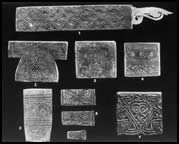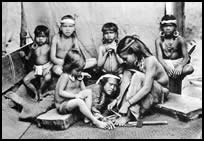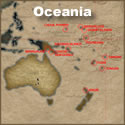The following is an excerpt from the Tattoo History Source Book: Borneo Tattoos
Borneo is one of the few places in the world
where traditional tattooing is still practiced today. Archeological evidence has
shown that ancestors of some contemporary native tribes have lived in Borneo for
over 50,000 years. The term, "Dayak" is applied to a variety of natives tribes
including the Ibans, Kayans and Kenyahs. |
|
Headhunting and tattooing were intricately connected in the magic, ritual and
social life of many tribes. The hand tattoo was a symbol of status in life and
also served as important function after death. It was supposed to illuminate the
darkness as the soul wandered in search of the River of the Dead. Tattooing,
piercing, and other traditional Dayak arts are of great antiquity. Many of the
traditional tattoo designs resemble decorative motifs found in the art of Bali
and Java, and the tattooing instruments and techniques used by the Dayaks are
similar to those found throughout Polynesia suggesting that Stone Age voyageurs
shared their knowledge throughout the area.
Today, few Dayak women are tattooed but the practice is still popular among
men. The designs are mainly traditional but some have commercial elements.
Amongst the Kayans, the men tattoo chiefly for ornament and no special
significance can be attached to the majority of designs employed; nor is there
any particular ceremonial or tattoo connected to the process of tattooing the
male sex.
If a Sarawak Kayan has taken the head of an enemy, he can have the back of
his hands and fingers covered with tattoos, but if he only has had a share in
the slaughter, one finger only, and generally the thumb, can be tattooed. On the
Mendalan River, the Kayan braves are tattooed on the left thumb only, not on the
carpals and the backs of the fingers, and the thigh pattern is reserved for
head-taking heroes.
Dog designs figure predominantly in Kayan art and the designs have been
copied by a lot of other tribes. On the deltoid region of the shoulders and on
the breasts, a rosette or star design is found. The rosette might have been
derived from the eye in the dog pattern.
Kayan women are tattooed in complicated serial designs over the whole
forearm, the backs of the hands, over the whole of the thighs below to below the
knees, and on the metatarsal surfaces of the feet. The tattooing of a Kayan girl
is a serious and long process taking up to four years. At ten years old a girl
would have her fingers and the upper part of her feet tattooed, and about a year
later her forearms would be completed, the thighs are partially tattooed during
the next year, and in the third or fourth year from the commencement the whole
operation should have been accomplished. Her tattoos would be completed before
he becomes pregnant because it is considered immodest to be tattooed after she
has become a mother.
Tattooing among the Kayan women is universal; they believe the designs act as
torches in the next world. The operation of tattooing is always performed by
women, never by men but men actually carve designs on wooden blocks.
 The tools used by a tattoo artist are simple, consisting of two or three
prickers and an iron striker that are kept in a wooden case. The prickers are
wooden rods with a short pointed head projecting at right angles at one end; to
the point of the head is attached a lump of resin in which are embedded three or
four short needles, their points alone projecting from the resin. The striker is
merely a short iron clad, half of which is covered with a string lashing. The
pigment is a mixture of soot, water and sugar cane juice, and is kept in a
shallow wooden cup. The best soot is believed to be obtained from the bottom of
the metal cooking pot. The tattoo designs are carved in high relief on blocks of
wood that are smeared with the ink and then pressed on the part of the body to
be tattooed, leaving an impression of the designs. The designs tattooed on women
are in longitudinal rows or traverse bands, and one or more zigzag lines mark
the divisions between the rows or bands.
The tools used by a tattoo artist are simple, consisting of two or three
prickers and an iron striker that are kept in a wooden case. The prickers are
wooden rods with a short pointed head projecting at right angles at one end; to
the point of the head is attached a lump of resin in which are embedded three or
four short needles, their points alone projecting from the resin. The striker is
merely a short iron clad, half of which is covered with a string lashing. The
pigment is a mixture of soot, water and sugar cane juice, and is kept in a
shallow wooden cup. The best soot is believed to be obtained from the bottom of
the metal cooking pot. The tattoo designs are carved in high relief on blocks of
wood that are smeared with the ink and then pressed on the part of the body to
be tattooed, leaving an impression of the designs. The designs tattooed on women
are in longitudinal rows or traverse bands, and one or more zigzag lines mark
the divisions between the rows or bands.
 The subject who is be tattooed lies on the floor, the artist and an assistant
squatting on either side. The artist first dips a piece of fiber from the sugar
palm into the pigment and, pressing this on the limb to be tattooed, plots out
the arrangement of the rows or bands of the design. The tattooist or her
assistant stretches the skin to be tattooed with their feet, and dipping a
pricker into the pigment, taps its handle with the striker as she works along a
line, driving the needle points into the skin. The operation is painful and
there is no antiseptic and often a new tattoo ulcerates.
The subject who is be tattooed lies on the floor, the artist and an assistant
squatting on either side. The artist first dips a piece of fiber from the sugar
palm into the pigment and, pressing this on the limb to be tattooed, plots out
the arrangement of the rows or bands of the design. The tattooist or her
assistant stretches the skin to be tattooed with their feet, and dipping a
pricker into the pigment, taps its handle with the striker as she works along a
line, driving the needle points into the skin. The operation is painful and
there is no antiseptic and often a new tattoo ulcerates.
Universal among the Kenyan-Klemantan of the Upper Mahakam and Batang, Kayan
there is a belief that after death the completely tattooed women will be allowed
to bathe in the mythical river Teland Julan, and that consequently they will be
able to pick up the pearls that are found in its bed; incompletely tattooed
women can only stand on the river banks, while un-tattooed will not be able to
approach the shores at all.
Tattoo Museum Bibliography, Resources and Links
 See all Oceanic Tattoo Culture Articles here
See all Oceanic Tattoo Culture Articles here
Additional Resources:
Tattoo History Source Book by Steve Gilbert
Trisha Allen - www.tattootraditions.alohaworld.com
See these Lars Krutak articles
Torches for the Afterlife: Women Tattoo Artists of Northern Borneo,
Borneo's Tattooed Women 'Warriors' - Weavers of the Skrang Iban
and In the Realm of Spirits: Traditional Dayak Tattoo in Borneo
for more information about tattoos and tattooing in Borneo.
NEXT >>
Easter Island
